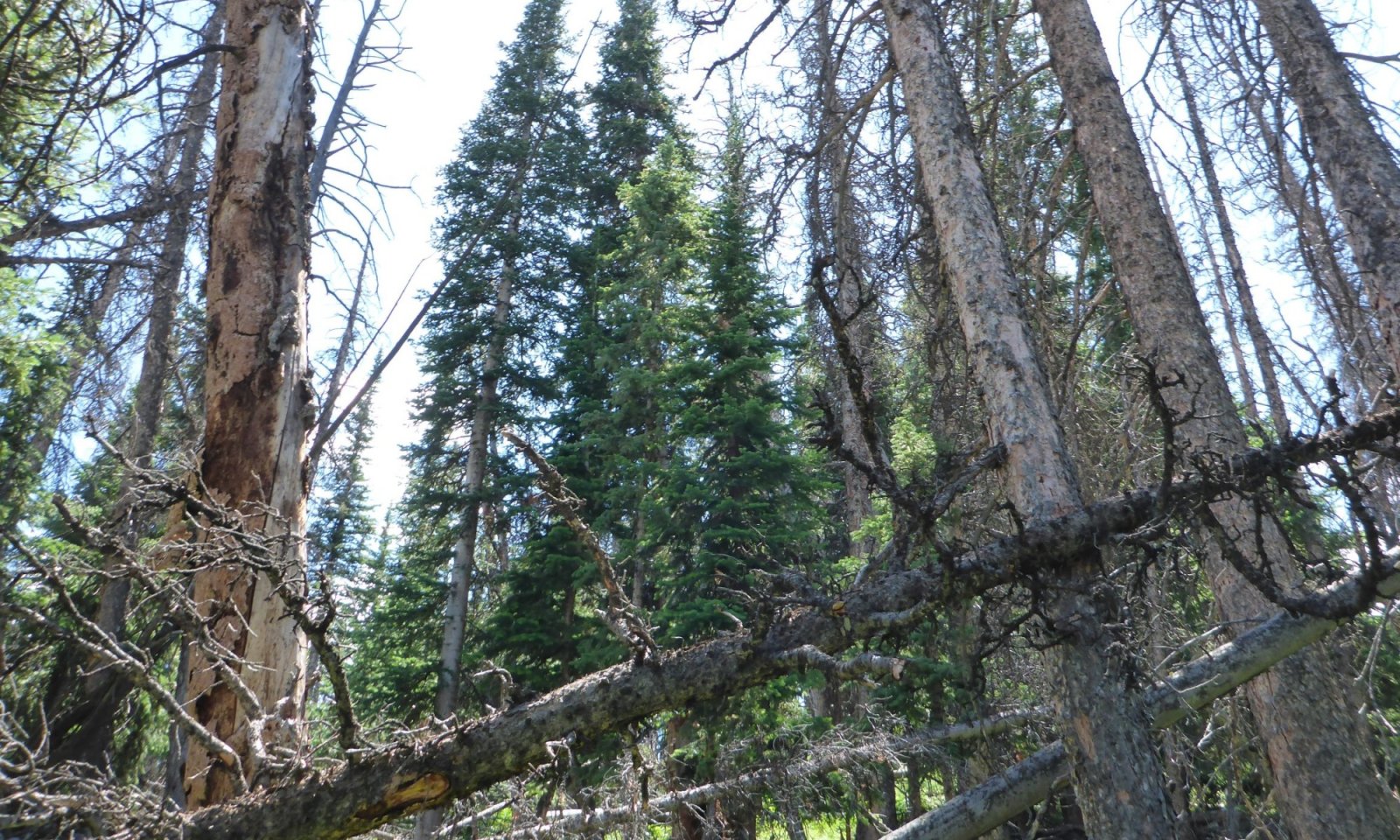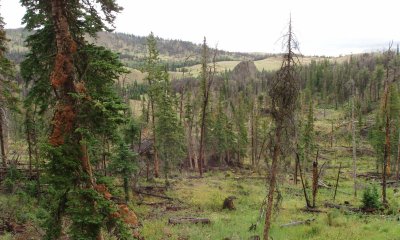
Upland Cold Woodland Group
Scenario model
Current ecosystem state
Select a state
Management practices/drivers
Select a transition or restoration pathway
-
Transition T1A
Fire, insect and disease impacts as well as logging can initiate the transition to the post disturbance state.
More details -
Restoration pathway R2A
Time for recovery with management of forest stand health is what drives the recovery to the Reference State.
More details -
No transition or restoration pathway between the selected states has been described
Target ecosystem state
Select a state
Description
Subalpine fir has the most extensive range reaching from the alpine zone to the fringes of the upland cool woodlands with Douglas-fir and Engelmanns spruce. Lodge pole pine is a major seral species in this community. This state is typical of old standing timber stands with a long duration fire return interval. Although fire has altered much of this community, the State is relatively fire resistant.
Characteristics and indicators
Subalpine fir are the dominant tree species in this state, with both old and young growth showing sufficient signs of reproduciton. There will be other sub-dominant species within the stand as well, including lodge pole pine, white bark pine, and engelmann spruce. The under story of this community is predominately shrubs and forbs with a few grasses intermixed. The composition of the under story is highly variable from north to south and from the west to eastern extent of this community.
Resilience management
Dead material resulting from insect and disease in old growth stands is the greatest threat of decline in these old growth forests. The fuel build up provides the risk of intense fire that will impact this community. Outside of this, this state is said to be resistant to significant change. Under story use by livestock and wildlife, where accessible, can have a significant impact to the under story composition. Utilization or browse on young growth and saplings can slow regeneration of key species especially in subalpine fir saplings.
Submodel
State 2
Post Disturbance





Description
The succession of the subalpine fir community following a major disturbance, generally an intense stand replacing fire or timber harvest/logging, includes two major stages before the stand can transition back to a subalpine fir community. These two phases include a shrub dominated community that then matures to a lodge pole pine community. Community composition will vary across the extent of this state based on parent materials, aspect, slope, and other site factors (historic use, past disturbance history) that are too broad to cover at this time.
Characteristics and indicators
The initial indicator of this state is the evidence of subalpine fir stands that have recently burned, disturbed, or have been harvested. The regeneration on this state includes primarily lodge pole pine at first, but engelmann spruce, white bark pine, and Douglas-fir are commonly associated species that may be present. Fireweed is a major indicator species of the disturbance, with ceanothus. As the community establishes and matures, lodge pole pine and Douglas-fir are the dominant forest components.
Resilience management
These communities are successional, and although the maturation process is relatively slow, the community is in a state of change or flux. Low intensity fires help to maintain a healthy forest as it matures, and influences the rate and type of change that occurs within each location. This state is resistant to significant change and is resilient, with adaptations occurring slowly - with time.
Submodel
Mechanism
Transition to the post disturbance state is driven primarily by stand replacement fires, as well as by insect and disease impacts on the tree stand. Major logging practices, including clear-cutting, can also be a mechanism to force this change. In this system fire frequency is long, and so the fire that occur are intense in nature.
Constraints to recovery
Time and stability of the site are the major constraints to recovery. Stability of the site relates to the slope, parent material and soil characteristics of these sites. After intense fires, erosion is a concern that could hinder recovery of this site.
Context dependence
Accessibility of the site by livestock and human impacts will influence some of the variability in the recovery constraints of this site.
Mechanism
Over time, and with the absence of fire, insect and disease damage, this community will mature back to the subalpine fir dominant tree stand. The use of timber management practices can assist in the restoration process. However, time is the key mechanism.
Relevant conservation practices
| Practice | External resources |
|---|---|
|
Upland Wildlife Habitat Management |
|
|
Forest Stand Improvement |
|
|
Forest Land Management |
|
|
Prescribed Forestry |
|
|
Patch-burning to enhance wildlife habitat |
|
|
Forest stand improvement for habitat and soil quality |
|
|
Wildlife corridors |
|
|
Forest stand improvement pre-treating vegetation and fuels |
|
|
Forest Stand Improvement, Prescribed burning |
|
|
Forest Stand Improvement for Soil Quality |
|
|
Forest stand improvement pre-treating vegetation and fuels preceding a prescribed fire |
Model keys
Briefcase
Add ecological sites and Major Land Resource Areas to your briefcase by clicking on the briefcase (![]() ) icon wherever it occurs. Drag and drop items to reorder. Cookies are used to store briefcase items between browsing sessions. Because of this, the number of items that can be added to your briefcase is limited, and briefcase items added on one device and browser cannot be accessed from another device or browser. Users who do not wish to place cookies on their devices should not use the briefcase tool. Briefcase cookies serve no other purpose than described here and are deleted whenever browsing history is cleared.
) icon wherever it occurs. Drag and drop items to reorder. Cookies are used to store briefcase items between browsing sessions. Because of this, the number of items that can be added to your briefcase is limited, and briefcase items added on one device and browser cannot be accessed from another device or browser. Users who do not wish to place cookies on their devices should not use the briefcase tool. Briefcase cookies serve no other purpose than described here and are deleted whenever browsing history is cleared.
Ecological sites
Major Land Resource Areas
The Ecosystem Dynamics Interpretive Tool is an information system framework developed by the USDA-ARS Jornada Experimental Range, USDA Natural Resources Conservation Service, and New Mexico State University.

